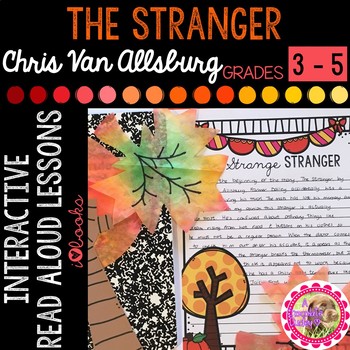The Stranger by Chris Van Allsburg
A Chocolate Dudley
507 Followers
Resource Type
Standards
CCSSRL.3.1
CCSSRL.3.3
CCSSRL.3.7
CCSSRL.4.1
CCSSRL.4.3
Formats Included
- PDF
Pages
102 pages
A Chocolate Dudley
507 Followers
What educators are saying
My students LOVED this story and the activities really helped them understand the story. They enjoyed trying to figure out who it was! It was awesome to see them able to use the evidence and they learned a lot about how to use setting to help them with their inferences.
Description
The Stranger by Chris Van Allsburg is the perfect fall read aloud!
The stranger's mysterious and odd behavior encourages children to use critical thinking skills and to infer. As your class listens to The Stranger by Chris Van Allsburg, look for clues to determine who the stranger is. Could he be "Father Nature", the season of autumn, or perhaps Jack Frost?
The Stranger Interactive Reading Lessons Include:
-Book Overview
-Common Core State Standards chart showing the standards the lessons are aligned to
-Objective Posters written in student-friendly language
-Pre-reading Activities (Word Splash, Anticipation Guide)
-Vocabulary Posters and Word Wall Cards
-Vocabulary Quiz and Answer Key
-ELA Vocabulary Posters
-Whole Class Inferring Activity
-Discussion Points that can be printed on Post-it notes and Answer Key
-Interactive Note-Booking Activities and examples (Setting, Inferring)
-Bloom's Taxonomy Based Journal Writing Prompts
-Opinion Writing Project
-Coffee Filter Art Project
-The Stranger Assessment and Answer Key
The stranger's mysterious and odd behavior encourages children to use critical thinking skills and to infer. As your class listens to The Stranger by Chris Van Allsburg, look for clues to determine who the stranger is. Could he be "Father Nature", the season of autumn, or perhaps Jack Frost?
The Stranger Interactive Reading Lessons Include:
-Book Overview
-Common Core State Standards chart showing the standards the lessons are aligned to
-Objective Posters written in student-friendly language
-Pre-reading Activities (Word Splash, Anticipation Guide)
-Vocabulary Posters and Word Wall Cards
-Vocabulary Quiz and Answer Key
-ELA Vocabulary Posters
-Whole Class Inferring Activity
-Discussion Points that can be printed on Post-it notes and Answer Key
-Interactive Note-Booking Activities and examples (Setting, Inferring)
-Bloom's Taxonomy Based Journal Writing Prompts
-Opinion Writing Project
-Coffee Filter Art Project
-The Stranger Assessment and Answer Key
Total Pages
102 pages
Answer Key
Included
Teaching Duration
2 Weeks
Last updated Aug 17th, 2018
Report this resource to TPT
Reported resources will be reviewed by our team. Report this resource to let us know if this resource violates TPT’s content guidelines.
Standards
to see state-specific standards (only available in the US).
CCSSRL.3.1
Ask and answer questions to demonstrate understanding of a text, referring explicitly to the text as the basis for the answers.
CCSSRL.3.3
Describe characters in a story (e.g., their traits, motivations, or feelings) and explain how their actions contribute to the sequence of events.
CCSSRL.3.7
Explain how specific aspects of a text’s illustrations contribute to what is conveyed by the words in a story (e.g., create mood, emphasize aspects of a character or setting).
CCSSRL.4.1
Refer to details and examples in a text when explaining what the text says explicitly and when drawing inferences from the text.
CCSSRL.4.3
Describe in depth a character, setting, or event in a story or drama, drawing on specific details in the text (e.g., a character’s thoughts, words, or actions).





